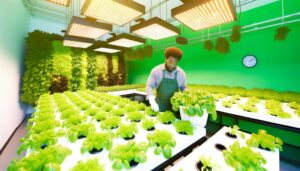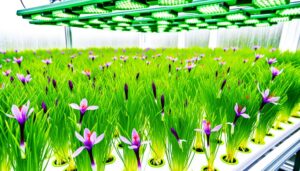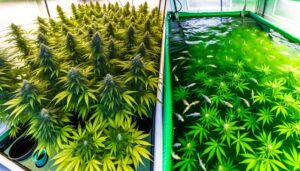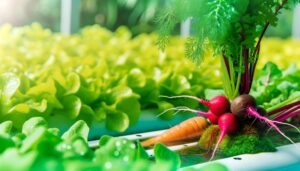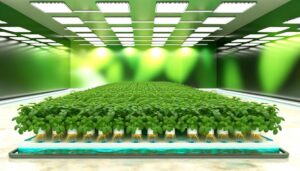Root Rot Vs Healthy Roots Hydroponics
In hydroponics, root rot is a detrimental condition caused by fungal pathogens like *Phytophthora* and *Pythium*, leading to necrotic, brown, and mushy roots due to impaired nutrient and oxygen uptake. Root rot proliferates in oxygen-depleted, high-moisture environments, often indicated by a foul odor.
Conversely, healthy roots are creamy white, firm, and have extensive branching, reflecting robust nutrient absorption and resilience to pathogens. Prevention involves maintaining ideal dissolved oxygen levels, balanced nutrients, and proper temperature control.
Understanding these differences is crucial for effective system management and maximizing plant health and productivity. Explore further to grasp thorough preventative and remedial strategies.

Key Takeaways
- Root rot causes roots to turn brown, become mushy, and emit a foul odor, contrasting with the creamy white color of healthy roots.
- Healthy roots are firm and turgid, indicating efficient nutrient and water uptake, unlike the slimy texture of infected roots.
- Pathogens causing root rot thrive in poor oxygen conditions, whereas adequate oxygenation and circulation prevent rot and support root health.
- Elevated water temperatures above 72°F promote root rot, while maintaining temperatures between 65-70°F helps sustain healthy roots.
Understanding Root Rot

Root rot, a pervasive and often devastating condition caused by various fungal and oomycete pathogens, compromises the integrity and function of plant root systems. This pathology disrupts water and nutrient uptake, leading to wilting, chlorosis, and plant death.
Pathogens such as *Phytophthora*, *Pythium*, and *Fusarium* colonize root tissues, inducing enzymatic degradation of cell walls and vascular blockages. The presence of necrotic, brown, and mushy roots is a hallmark of advanced infection stages.
In hydroponic systems, root rot can proliferate rapidly due to high-moisture environments, exacerbating the spread of these pathogens. Early detection through visual assessment and molecular diagnostics is vital for effective management and mitigation.
Understanding the pathophysiology of root rot is essential for developing targeted control strategies.
Causes of Root Rot
Environmental factors, such as excessive soil moisture and poor drainage, create conditions conducive to the proliferation of root rot pathogens.
In hydroponic systems, the primary culprits are Pythium spp. and Phytophthora spp., which thrive in oxygen-depleted environments. Elevated water temperatures, often exceeding 72°F (22°C), exacerbate oxygen solubility issues, facilitating pathogen growth.
Additionally, poor water circulation reduces the availability of dissolved oxygen, further stressing root systems. Inadequate sterilization practices and contaminated equipment introduce and spread these pathogens.
Nutrient imbalances, particularly excessive nitrogen, can weaken plant defenses, making roots more susceptible to infection. The interplay of these factors greatly disrupts root function, leading to compromised nutrient uptake, stunted growth, and eventual plant mortality.
This highlights the need for vigilant environmental control in hydroponic setups.
Identifying Root Rot
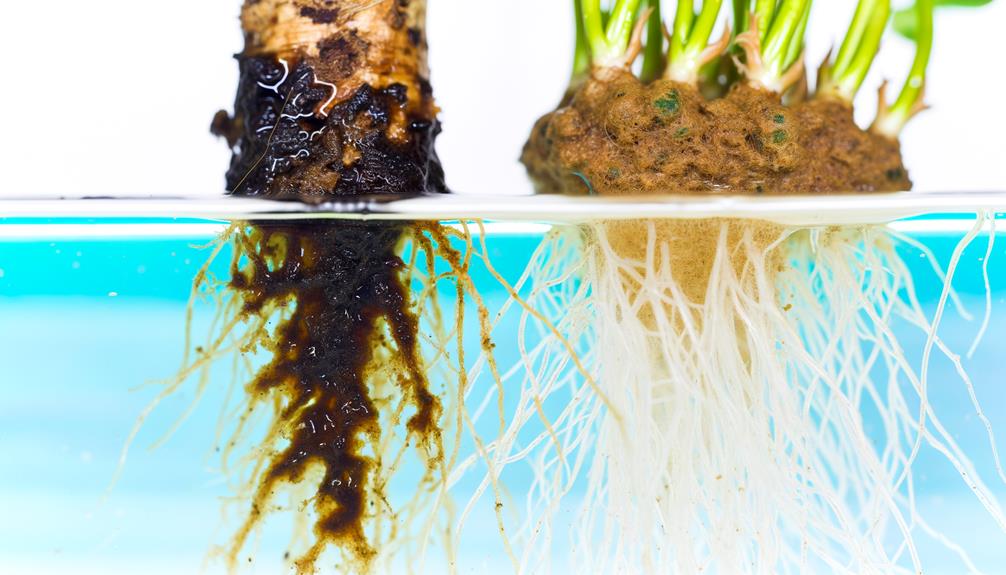
Recognizing the early signs of root rot is imperative for mitigating the detrimental effects caused by these pathogenic infestations. A systematic approach to identification involves careful observation and analysis.
Key indicators of root rot include:
- Discoloration: Healthy roots are typically white or light tan. Infected roots often exhibit dark brown or black hues.
- Texture Changes: Diseased roots become slimy and mushy, contrasting with the firm texture of healthy roots.
- Odor: The presence of a foul, sour smell can signal bacterial or fungal activity.
- Growth Pattern Alterations: Affected roots may exhibit stunted or uneven growth.
These signs provide critical evidence for early diagnosis, enabling timely intervention to prevent further spread and damage.
Proper identification is the cornerstone of effective root rot management in hydroponic systems.
Symptoms of Affected Plants
The manifestation of root rot in plants is often evidenced by symptoms such as leaf discoloration and wilting, which indicate impaired nutrient and water uptake.
Additionally, a characteristic foul odor emanating from the root zone is typically associated with microbial activity and tissue decomposition.
These indicators are critical for early detection and effective management of root rot to safeguard plant health.
Discoloration and Wilting
Discoloration and wilting are primary indicators of root rot in plants, often manifesting as yellowing leaves and drooping stems due to impaired nutrient and water uptake.
These symptoms are critical for early diagnosis, allowing for timely intervention. Key manifestations include:
- Yellowing of Leaves: Chlorosis occurs as nutrient absorption is hampered.
- Wilting of Stems and Leaves: Reduced water uptake leads to loss of turgor pressure.
- Leaf Drop: Severely affected plants may shed leaves prematurely.
- Stunted Growth: Limited nutrient availability hinders overall plant development.
These symptoms are evidence-based markers for identifying root rot, distinguishing them from healthy roots in hydroponic systems.
Understanding these signs is essential for maintaining plant health and optimizing hydroponic growth conditions.
Foul Odor Presence
A prominent indicator of root rot is the presence of a foul odor emanating from the root zone, signifying anaerobic conditions and microbial decay. This malodor arises due to the proliferation of pathogenic microorganisms such as Pythium, Phytophthora, and Fusarium, which thrive in oxygen-deprived environments.
The decomposition of organic matter under these anaerobic conditions releases volatile sulfur compounds, particularly hydrogen sulfide, contributing to the characteristic rotten egg smell. A healthy hydroponic system, by contrast, maintains adequate oxygenation, preventing the growth of harmful microbes and the resultant foul odor.
Regular monitoring of dissolved oxygen levels and root zone cleanliness are essential preventative measures. Early detection and intervention are critical in mitigating the adverse effects of root rot on plant health and yield.
Preventing Root Rot
Implementing effective strategies is essential for preventing root rot, guaranteeing the long-term health and energy of plants.
Root rot is mainly caused by fungal pathogens thriving in overly moist environments. To mitigate this, hydroponic systems must maintain ideal conditions.
Key strategies include:
- Oxygenation: Guarantee adequate dissolved oxygen in the nutrient solution to prevent anaerobic conditions that foster pathogenic growth.
- Sterilization: Regularly sterilize equipment and reservoirs to eliminate potential fungal spores.
- Temperature Control: Maintain water temperatures between 65-70°F (18-21°C) to inhibit fungal proliferation.
- Drainage and Circulation: Use well-designed systems to enhance nutrient solution circulation and prevent stagnant water zones.
Adopting these measures will create an inhospitable environment for pathogens, safeguarding root health and promoting vigorous plant growth.
Treating Root Rot
Effective treatment of root rot necessitates a multifaceted approach that targets the underlying causes and employs both chemical and cultural interventions to restore plant health.
Initially, removing affected root sections is essential, utilizing sterile cutting tools to prevent pathogen spread. Implementing systemic fungicides like those containing phosphorous acid can inhibit further fungal proliferation.
Additionally, the introduction of beneficial microbes, such as Bacillus subtilis, can outcompete pathogenic fungi. Cultural practices include optimizing oxygenation through enhanced aeration systems and ensuring proper nutrient balance to alleviate plant stress.
Maintaining water temperature between 18-22°C (64-72°F) is also imperative since higher temperatures exacerbate fungal growth. Monitoring and adjusting pH levels to 5.5-6.5 can further suppress pathogenic activity, fostering a conducive environment for recovery.
Characteristics of Healthy Roots
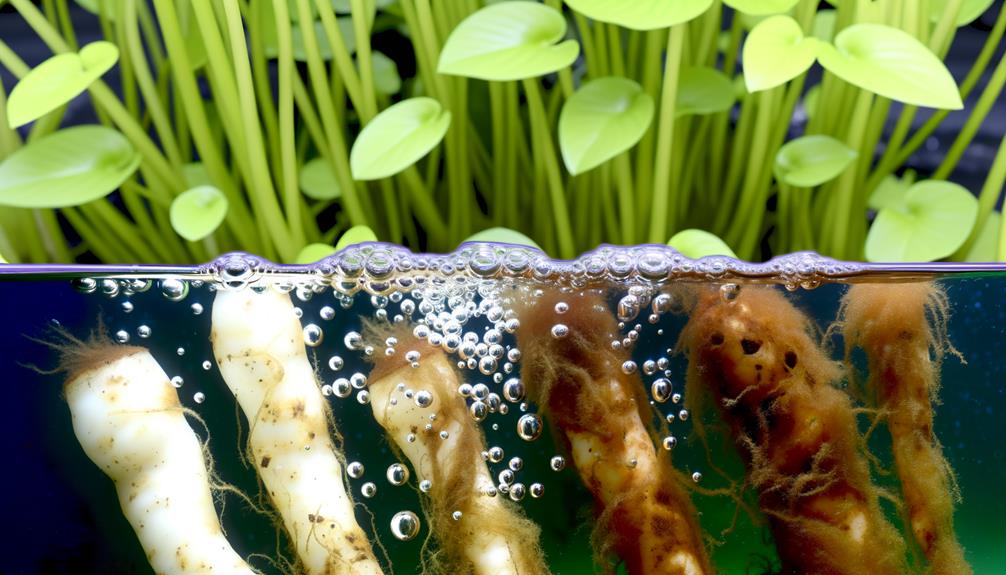
Healthy roots exhibit specific characteristics that are indicative of their ideal function and overall plant health.
These include a consistent, creamy white coloration, a firm and turgid texture, and a robust growth pattern characterized by extensive branching and spread.
Such attributes are essential for efficient nutrient and water uptake, ultimately supporting vigorous plant growth and resilience.
Optimal Root Color
Typically, the ideal color of healthy roots is a creamy white, indicating proper nutrient absorption and overall root health. This coloration can be attributed to several factors:
- Oxygen Availability: Adequate oxygenation guarantees roots remain vibrant and capable of efficient nutrient uptake.
- Nutrient Balance: Properly balanced macronutrients and micronutrients prevent discoloration, which can signal deficiencies or toxicities.
- Disease-Free Environment: Absence of pathogens like Pythium spp. helps in maintaining the creamy white appearance, as infections often cause browning or blackening.
- Optimal pH Levels: Maintaining a pH range of 5.5 to 6.5 guarantees nutrient solubility and uptake, promoting healthy root color.
These factors collectively guarantee that the roots exhibit their characteristic creamy white hue, serving as a visual cue for growers to gauge root health effectively.
Firmness and Texture
Characterized by a robust and slightly resilient structure, the firmness and texture of healthy roots are essential indicators of their overall vigor and functional capacity. Healthy hydroponic roots exhibit a turgid, firm texture, signifying efficient water and nutrient uptake. This firmness is a result of well-developed cell walls and ideal turgor pressure, facilitating robust metabolic activity and growth.
Conversely, any deviation towards a mushy or overly soft texture often heralds the onset of root rot, caused by pathogenic organisms and less-than-ideal environmental conditions.
Advanced studies demonstrate that maintaining a controlled hydroponic environment, including appropriate oxygenation and nutrient balance, is critical in preserving root firmness and texture, and so ensuring the sustainability of the plant's health and productivity.
Growth and Spread
The robust proliferation and extensive network formation of healthy roots are indicative of ideal nutrient absorption and efficient plant anchorage. These characteristics are paramount in hydroponic systems where roots are the primary interface for nutrient uptake.
Healthy root systems exhibit:
- Extensive Lateral Growth: Promotes greater surface area for nutrient and water absorption.
- Uniform Root Distribution: Guarantees balanced nutrient uptake, preventing localized deficiencies.
- White, Turgid Appearance: Reflects superior oxygenation and absence of pathogenic infections.
- Active Root Tips: Indicate ongoing growth and effective nutrient solution uptake.
These traits underscore the importance of maintaining excellent environmental conditions, such as oxygenation and nutrient balance, to support vigorous root development.
Studies consistently show that well-maintained hydroponic systems yield healthier roots, leading to higher plant productivity and resilience.
Benefits of Healthy Roots
Understanding the benefits of healthy roots is crucial for maximizing plant growth, as they are essential for nutrient absorption, water uptake, and providing structural stability.
In hydroponic systems, robust root health greatly enhances the efficiency of nutrient uptake, leading to accelerated growth rates and higher yields.
Healthy roots also guarantee ideal water absorption, preventing plant stress and promoting vigorous development.
The structural integrity provided by a well-developed root system supports the plant's physical stability, decreasing susceptibility to toppling or mechanical damage.
Additionally, healthy roots exhibit a greater resistance to pathogens and environmental stressors, thereby reducing the incidence of diseases such as root rot.
Ultimately, maintaining root health translates to increased productivity, quality, and resilience in hydroponic cultivation.
Best Practices for Root Health
To guarantee ideal root health in hydroponic systems, implementing best practices such as maintaining proper oxygenation, monitoring pH levels, and employing effective disease management strategies is imperative.
Assuring optimal root conditions involves several key actions:
- Oxygenation: Utilize air stones or diffusers to maintain dissolved oxygen levels above 5 ppm, essential for root respiration and nutrient uptake.
- pH Monitoring: Keep the nutrient solution pH within the ideal range (5.5-6.5) to guarantee nutrient availability and prevent root stress.
- Temperature Control: Maintain nutrient solution temperatures between 18°C and 22°C to avoid thermal stress, which can exacerbate root rot.
- Sanitation: Regularly clean and sterilize equipment to minimize pathogen proliferation, using agents like hydrogen peroxide or bleach.
These practices collectively foster a robust root system, vital for plant health and productivity.
Monitoring Root Health
Effective monitoring of root health necessitates a multifaceted approach that includes regular visual root examination to identify early signs of discoloration or decay.
Balancing the nutrient solution is critical to guarantee ideal root function and prevent imbalances that could predispose roots to rot.
Additionally, continuous assessment of environmental conditions such as temperature, humidity, and oxygen levels is essential for maintaining a root system conducive to healthy plant growth.
Visual Root Examination
A thorough visual examination of the roots provides essential insights into the plant's overall health, enabling early detection of root rot and other potential issues. Regular root inspection should focus on several key indicators:
- Color: Healthy roots typically exhibit a white or light tan hue. Darkening or browning may indicate the onset of root rot.
- Texture: Firm and turgid roots suggest liveliness, while mushy or slimy textures are symptomatic of rot or fungal infections.
- Odor: Healthy roots should be odorless. A foul or rancid smell is often a sign of decay.
- Growth Pattern: Uniform root growth is preferable. Stunted or uneven root development can signal nutrient deficiencies or pathogenic activity.
Systematic visual evaluations are crucial in maintaining ideal hydroponic root health.
Nutrient Solution Balance
Maintaining a balanced nutrient solution is imperative for supporting healthy root systems and preventing the onset of root rot.
Precise management of nutrient concentrations, pH levels, and electrical conductivity (EC) is critical. Research indicates that imbalanced nutrient solutions can stress plants, making roots susceptible to pathogens like Pythium spp.
Ideal pH levels, typically between 5.5 and 6.5, facilitate nutrient uptake, while deviations can lead to deficiencies or toxicities. Regular monitoring using calibrated pH meters and EC sensors guarantees consistency.
Additionally, routine replacement of the nutrient solution prevents the accumulation of detrimental substances. Empirical evidence underscores the importance of maintaining recommended nutrient ratios to foster robust root growth and avert conditions conducive to root rot.
Environmental Conditions Impact
Continuous monitoring of environmental conditions such as temperature, humidity, and light intensity is crucial for evaluating and maintaining root health, as deviations from ideal ranges can predispose plants to root rot.
Evidence-based practices indicate that the following parameters should be closely observed:
- Temperature: Ideal root zone temperatures range between 18-22°C. Higher temperatures can foster pathogenic growth.
- Humidity: Maintaining relative humidity between 50-70% can help prevent fungal infections.
- Light Intensity: Sufficient light promotes photosynthesis and root strength, but excessive light can lead to overheating.
- Oxygen Levels: Dissolved oxygen in the nutrient solution should be above 5 mg/L to promote root respiration and nutrient uptake.
These environmental factors are pivotal in sustaining root health and preventing root rot in hydroponic systems.
Hydroponic System Maintenance
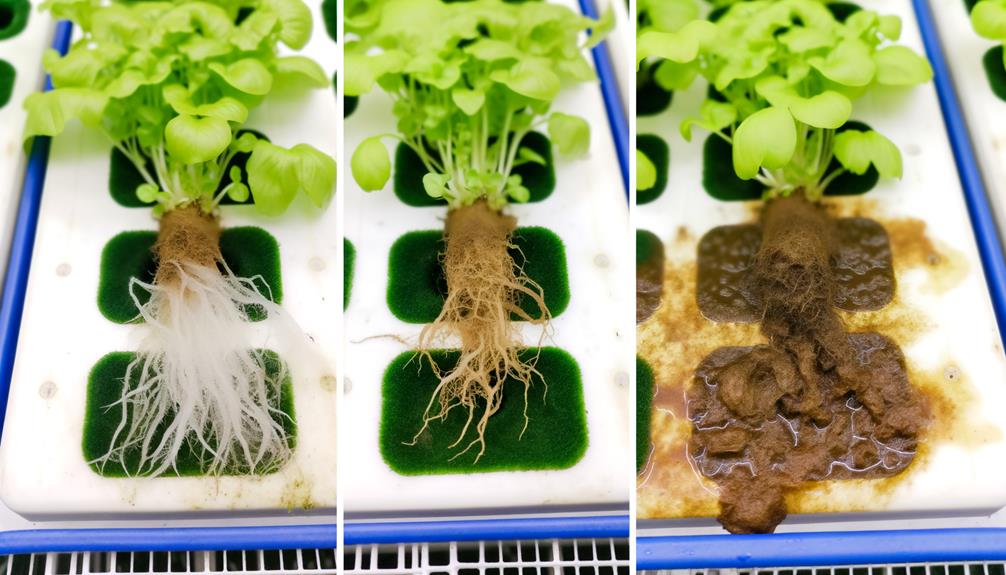
Effective hydroponic system maintenance is critical to preventing root rot and ensuring peak plant health and productivity. A thorough maintenance routine includes regular monitoring of pH levels, nutrient concentration, and water temperature. Evidence indicates that maintaining a pH range of 5.5 to 6.5 maximizes nutrient uptake, while nutrient solution temperatures between 65-75°F minimize pathogen proliferation. Additionally, system cleanliness is paramount; biofilm accumulation and debris can harbor pathogens detrimental to root health.
| Parameter | Ideal Range |
|---|---|
| pH Levels | 5.5 – 6.5 |
| Nutrient Solution Temperature | 65-75°F |
| Cleaning Frequency | Weekly with disinfectant |
Consistent monitoring and adherence to these parameters effectively reduce the risk of root rot, promoting robust root systems and vigorous plant growth in hydroponic environments.
Conclusion
In summary, root rot poses an insidious threat to hydroponic systems, undermining plant health with astonishing efficiency.
Identifying and addressing root rot through meticulous monitoring and rigorous maintenance practices are crucial.
The benefits of maintaining healthy roots cannot be overstated, as they form the cornerstone of robust plant growth and ideal yields.
Employing best practices and preventive measures will guarantee the sustainable success of hydroponic cultivation, safeguarding against the catastrophic impact of root rot.

